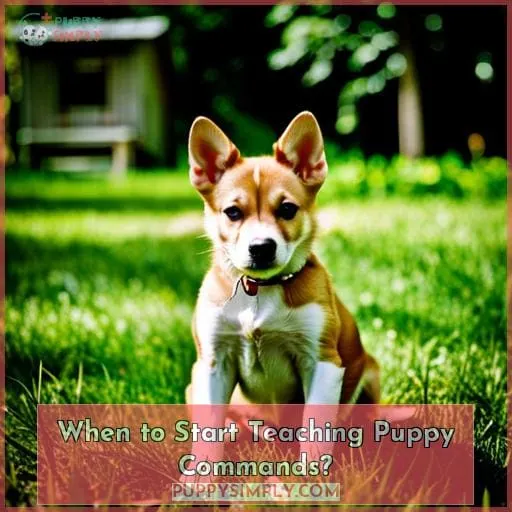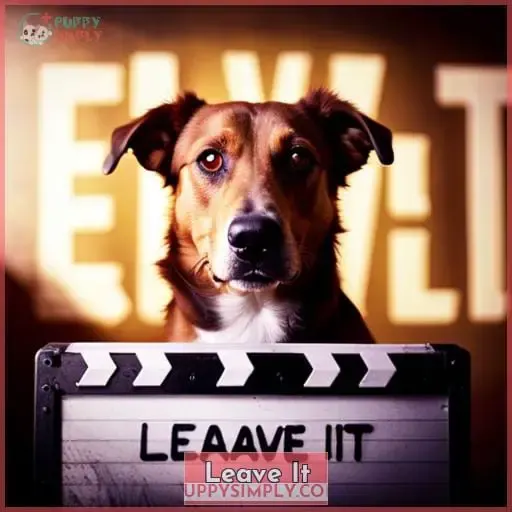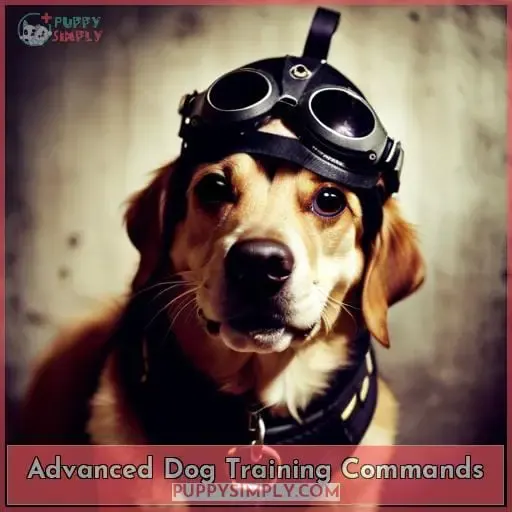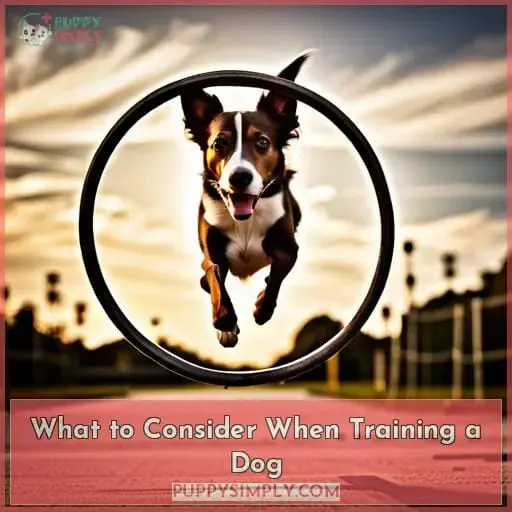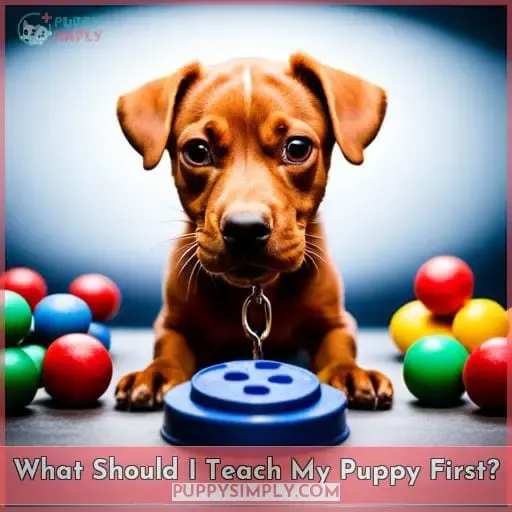This site is supported by our readers. We may earn a commission, at no cost to you, if you purchase through links.
It’s no coincidence that you’re here looking for advice on training your beloved pup.
Teaching six basic obedience commands can be just the start of a lifelong journey of learning between you and your dog.
So if you’re ready to dive into teaching 6 basic dog training obedience commands, then read on!
Table Of Contents
- Key Takeaways
- What Are the 6 Basic Dog Training Commands?
- When to Start Teaching Puppy Commands?
- Lie Down
- Release
- Leave It
- Advanced Dog Training Commands
- What to Consider When Training a Dog
- When Should You Start Training Your Puppy?
- What Should I Teach My Puppy First?
- Should I Use Treats to Train My Puppy?
- Frequently Asked Questions (FAQs)
- Conclusion
Key Takeaways
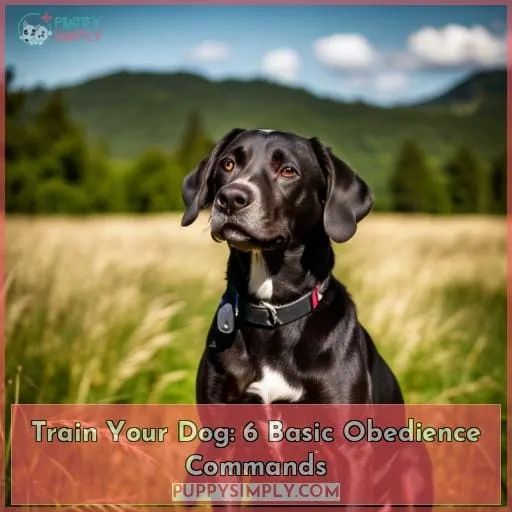
- Training your dog should start as soon as they adapt to their new home.
- Consistency and positive reinforcement are crucial for successful training.
- Crate training provides a safe space for your puppy and helps with training.
- The six basic obedience commands are Sit, Lie Down, Stay, Release, Leave It, and Come.
What Are the 6 Basic Dog Training Commands?
You can teach your pup to be the best-behaved pooch on the block with just six simple commands: Sit, Lie Down, Stay, Release, Leave It, and Come. These basic commands are key for teaching your pup good behavior and will help them gain command confidence.
Start by introducing crate training; this will give your puppy a safe space where they can relax when needed or during times of distraction.
The most important skill taught in dog obedience is sitting. Make sure that once you have given the sit command, not to reward until all four paws are firmly on the ground. Then use positive reinforcement such as treats or verbal praise when done correctly.
Another useful transition command is down/lay down, which helps control movement like taking keys out of an ignition! Remember, consistency is vital. So if giving multiple commands, do not change the order, otherwise, it could confuse pups.
The stay and come exercises should both be practiced regularly off leash but always within sight. If recall isn’t successful, distract them with a toy or plastic bottle filled with pennies (never shake!) before recalling again while praising success upon completion.
Finish up by saying ‘release’ after each exercise, allowing him/her freedom after completing tasks successfully.
Finally, remember patience goes hand in hand here. Don’t move onto more complicated tricks too soon as mastering these basics first proves beneficial over time.
When to Start Teaching Puppy Commands?
Start your pup’s journey to becoming a well-behaved pooch by introducing basic commands as soon as they’ve adapted to their new home. Socialization, crate training, and potty training are key elements in puppy development that should be started early on for best results.
Patience and consistency from the owner are essential when teaching these commands – positive reinforcement or treats can be used to reward good behavior during this process.
One of McMillan’s favorite dog training techniques is using a plastic bottle filled with pennies while saying ‘No!’ This discourages jumping on visitors or furniture without hurting or scaring the pup too much.
Each command has its own purpose:
- Sit helps transition between other directives
- Down/Lay down aids control movement
- Stay prevents dogs from running into streets
- Release indicates when the dog is in command
- Leave it teaches impulse control
- Come ensures safety in off-leash situations among others!
Puppy owners must remember not to overload them with too many advanced tricks before mastering basic obedience first – doing so could cause confusion and make things harder later on down the line!
Introducing routines & boundaries provides structure that prevents dangerous situations such as running out into roads unsupervised – creating an environment where both man & canine thrive together happily ever after!
Training one command at a time gradually increases the complexity level over time until all six core skills are mastered successfully!
Here’s how you can ensure success:
- Provide plenty of mental stimulation through playtime activities like hide n’ seek games, which help improve focus & concentration levels during lessons (this works best if done prior to meals)
- Ensure low distraction environments so pups don’t get easily distracted, especially while learning trickier tasks
- Use positive reinforcement methods like verbal praises and rewards whenever possible to ease stress levels, making progress faster than expected.
Lie Down
Once you’ve mastered the sit command, it’s time to move onto the lie down position. This is a great way to control your pup’s movement and keep them from running away in off-leash situations.
Consistency matters here. Practice this command several times a day until they understand what you’re asking of them! And remember that positive reinforcement works best – reward good behavior with verbal praises or treats (McMillan sticks by using a bag of treats!).
Mental training should not be neglected either. This can help build focus and concentration during lessons, which will make progress faster than expected.
Training benefits both man and canine alike. Obedience commands like ‘lie down’ teach our four-legged friends how to behave properly around people as well as other animals, so everyone stays safe without scaring or hurting one another in any way whatsoever.
So go ahead, grab some kibble rewards (or McMillan’s plastic bottle filled with pennies), then get ready because all dogs – big & small – can learn proper manners through consistent repetition regardless of age.
Release
Gently cue your pup with the word ‘Release’ to let them know it’s time to move on from their current position. This is an essential basic obedience command and a perfect way for you to maintain control of your dog in different situations.
Teaching Release will provide important lessons about good manners, self-control, respect, and responsibility that can be used throughout life.
Positive reinforcement works best when teaching this command; consider using verbal praises or treats as rewards for successful attempts.
Patience may be needed too – especially with senior dogs who require more effort during training sessions while keeping distractions at bay within their low distraction environment (McMillan recommends such environments).
Training benefits both man and canine alike – use these commands daily as part of routines so your pup knows how to behave properly around people or other animals without scaring or hurting one another in any way whatsoever.
It’s all about creating positive experiences between human & pet by incorporating consistency through patience & love along with mental stimulation exercises that are tailored according to age/stage/breed needs for success – something McMillan strongly believes in himself too! So go ahead – start building bonds now starting from mastering this perfect command today…you won’t regret it once those tails keep wagging happily ever after!!
Leave It
Once your pup has mastered the ‘Release’ command, you can move on to teaching them the ‘Leave It’ command. This is an essential basic obedience skill and a great way for you to maintain control of your dog in different situations.
Teaching this command will also provide important lessons about good manners, self-control, respect, and responsibility that can be used throughout life.
When introducing this new behavior cue, start by standing with your pup at a comfortable distance from any distractions, such as another dog or person.
Positive reinforcement works best when training dogs, so consider using verbal praises or treats as rewards for successful attempts – just like adjunct professor McMillan recommends too!
Consistency matters here: practice several times a day until they understand what you’re asking of them.
Mental stimulation exercises are also highly recommended when it comes to crate training puppies.
So go ahead – let us take our first steps today towards mastering this perfect ‘Leave It’ Command now… you won’t regret it once those tails keep wagging happily ever after!!
Advanced Dog Training Commands
Are you ready to take your pup’s training to the next level? Once they have mastered the basics, it is time for advanced commands such as ‘Ask Permission’ and ‘Touch’. These two behaviors will not only teach them important lessons about respect and responsibility but also provide a sense of security in different situations.
Ask for Permission
Take your training to the next level and show off your pup’s obedience skills by teaching them to ‘Ask for Permission’ – a highly advanced behavior that will help build trust between you both! Positive reinforcement, consistency, and patience are key when introducing this command.
Mental training is also important in order for long-term success with good housekeeping habits. It’s best done in a low distraction environment such as the New York Writing Room or Muse Writing Center.
Reward positive behaviors with treats or verbal praise whenever possible while avoiding running vehicles or other dangerous scenarios; never forget safety first!
With practice and application of these techniques, basic commands like sit can become more intricate such as asking permission before entering rooms or jumping on people–a valuable asset at any dog park visit!
Through providing boundaries together within routines, hard work pays off with desirable results: a happy pup ready to take on life’s adventures all while staying safe along each step taken towards freedom & power through mastery!!
Touch
Teach your pup the ‘Touch’ command as an advanced behavior and see how quickly they understand – can you believe what they’re capable of? Positive reinforcement, mental training, patience, and consistency are key for the best results.
Train in a low distraction environment, such as your family home, to ensure success.
Rewards should be given for positive behaviors that will prevent dangerous situations from arising.
What to Consider When Training a Dog
When training your pup, consider the environment and rewards you’re using, as well as patience and consistency. Socializing puppies early on is essential for their development into a calm and obedient dog.
Consistency matters when teaching basic commands such as Sit, Stay, or Come, so they understand what’s expected of them at all times. Reward good behavior with treats or verbal praise to encourage positive behaviors in the future.
Avoid distractions by making sure there are no other animals around during training sessions.
Mental stimulation activities like crate training can also help strengthen their understanding of these commands while helping to prevent common issues like barking or separation anxiety later in life.
For an untrained rescue dog who may have behavioral issues due to past experiences, it’s important to be patient when introducing new routines and boundaries. Start small, aiming for one command each day until they feel comfortable enough with it before moving onto another one.
Additionally, creative nonfiction techniques such as the ‘stay’ skill, where you ask your pet to stay still even if something exciting happens around them, can become really helpful over time too.
Ultimately, remember that mastering basic dog obedience commands takes dedication from both yourself and your pup.
When Should You Start Training Your Puppy?
When it comes to training your pup, the sooner you start, the better. Socialization is extremely important for puppies and should begin as soon as they’ve adjusted to their new environment.
Crate training is also a great way to help them become familiar with their surroundings while teaching them basic commands such as ‘Go in’, ‘Come out’ or even ‘Stay’.
Consistency plays a key role when introducing these routines; rewarding good behavior with treats or verbal praise helps reinforce positive behaviors in the future. It’s also essential that you take into consideration what type of environment you’re going to train in – try avoiding any distractions like other animals during sessions so that your dog stays focused on what’s asked of him/her.
A reward system based on positive reinforcement rather than punishment works best too – remember: dogs learn through body language far quicker than words alone!
Becoming a responsible pet owner means ensuring your furry friend has all the tools necessary for success – whether it’s developing off-leash skills, becoming comfortable around strangers or learning how not jump up excessively when greeting people at home – taking part in regular obedience classes provides many benefits both mentally and physically which ultimately leads towards having a well balanced pooch who knows how behave properly under different circumstances whilst being able navigate situations independently without relying solely upon its beloved human guardian(s).
Plus completing advanced courses (such as Canine Good Citizen) always looks fantastic upon resumes once sent off potential employers and universities alike.
What Should I Teach My Puppy First?
Start teaching your pup good manners and behavior early on to prevent dangerous situations in the future! Incorporate socialization, crate training, positive reinforcement, routine boundaries, and mental training into your puppy’s life.
These steps are essential for achieving an obedient dog, according to New York University’s School of Veterinary Medicine.
Sit is a great transition command because dogs tend to learn it fairly quickly. It allows you to move onto other directives with ease. Teaching Down or Lay Down helps control movement, while Stay prevents them from running into hazardous places like roads or riverside paths.
Introducing Heel can make walking together much smoother in busy urban areas, especially if you’re looking towards long-form features such as Off (to discourage jumping) and Leave It (teaching impulse control).
Use Come often during off-leash activities to ensure your pup stays within reach at all times. Repetition will help ensure they understand each command correctly before progressing onto advanced commands like Permission Seeking or Touch Redirecting Attention.
These commands enable owners to have greater control through mastering different techniques.
Treats are always encouraged during training sessions. Providing rewards whenever appropriate encourages better results than punishment alone over time. Just remember that patience and consistency are key factors, regardless of the stage you and your pup are at.
Should I Use Treats to Train My Puppy?
Yes, treats can be an effective way to reward your pup for learning and following obedience commands. However, it’s important to know the treat frequency and how you should use positive reinforcement during training sessions.
The key is consistency: if you don’t provide consistent rewards when your pup exhibits good behavior, then they won’t learn what is expected of them.
Using treats as a reward also gives owners the perfect opportunity to practice advanced versions of basic commands like Sit or Stay in public places such as parks or beaches by increasing distance from one another while maintaining eye contact with each other.
The most important command any puppy should learn first though is Leave It, which teaches impulse control – something that will help keep all pups safe no matter where they are! But remember, even when using treats as motivation, always strive towards rewarding behaviors rather than punishing mistakes.
This creates healthier relationships with dogs through mutual respect over time instead of fear.
As long as owners remain patient yet persistent throughout every training session, there’s no limit on what kind of results can be achieved with pooches big or small alike!
Frequently Asked Questions (FAQs)
How often should I train my dog?
Train your pup regularly! Start with short sessions and gradually increase the duration as your dog’s skills improve. Stay consistent for the best results, and don’t forget to reward good behavior—it pays off in the long run.
What is the best way to teach a new command?
Train your dog using positive reinforcement, consistency, patience, and rewards. Begin with one command at a time in a low-distraction environment.
How long does it take to train a dog?
Training a dog takes patience and consistency. With positive reinforcement, it’s possible to teach your pup new commands in weeks, or even days! Use treats as rewards and practice each command one at a time for the best results.
What are the best rewards for training a dog?
The best rewards for training a dog depend on the pup’s personality. Positive reinforcement of desired behavior can come in many forms, from tasty treats to verbal praise and petting.
How do I know if my dog has learned a command?
To determine if your dog has learned a command, observe their behavior for consistency. Pay attention to their body language and watch for signs of comprehension when you repeat the command. If your dog consistently responds with minimal prompting, they have likely mastered it! Remember to reward positive behavior to reinforce learning and keep the training enjoyable.
Conclusion
Training your puppy is a rewarding experience that can make life both easier and more enjoyable for you and your pup. With the help of basic obedience commands, you can keep your pup safe and healthy while teaching them the skills to be a well-behaved companion.
Take the time to teach your pup these basic commands, and you can help them develop a sense of trust, security, and respect. Not only will your puppy be happier, but you’ll also have peace of mind knowing that your pup is safe and secure.
So start training today and watch as your pup grows into a loving and obedient fur-friend.


